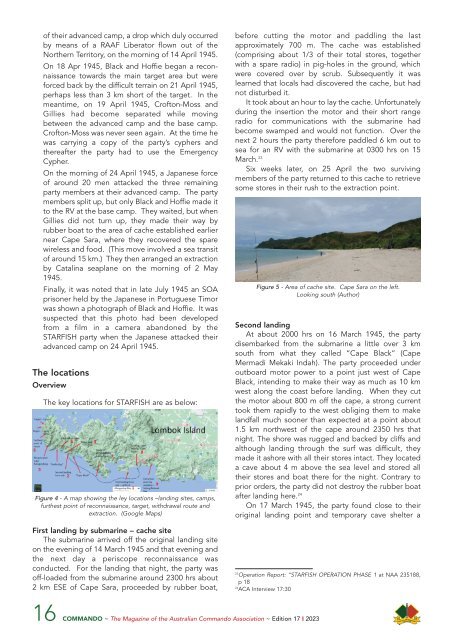Commando Edition 17 2023
The Official Commando News Magazine
The Official Commando News Magazine
Create successful ePaper yourself
Turn your PDF publications into a flip-book with our unique Google optimized e-Paper software.
of their advanced camp, a drop which duly occurred<br />
by means of a RAAF Liberator flown out of the<br />
Northern Territory, on the morning of 14 April 1945.<br />
On 18 Apr 1945, Black and Hoffie began a recon -<br />
naissance towards the main target area but were<br />
forced back by the difficult terrain on 21 April 1945,<br />
perhaps less than 3 km short of the target. In the<br />
meantime, on 19 April 1945, Crofton-Moss and<br />
Gillies had become separated while moving<br />
between the advanced camp and the base camp.<br />
Crofton-Moss was never seen again. At the time he<br />
was carrying a copy of the party’s cyphers and<br />
thereafter the party had to use the Emergency<br />
Cypher.<br />
On the morning of 24 April 1945, a Japanese force<br />
of around 20 men attacked the three remaining<br />
party members at their advanced camp. The party<br />
members split up, but only Black and Hoffie made it<br />
to the RV at the base camp. They waited, but when<br />
Gillies did not turn up, they made their way by<br />
rubber boat to the area of cache established earlier<br />
near Cape Sara, where they recovered the spare<br />
wireless and food. (This move involved a sea transit<br />
of around 15 km.) They then arranged an extraction<br />
by Catalina seaplane on the morning of 2 May<br />
1945.<br />
Finally, it was noted that in late July 1945 an SOA<br />
prisoner held by the Japanese in Portuguese Timor<br />
was shown a photograph of Black and Hoffie. It was<br />
suspected that this photo had been developed<br />
from a film in a camera abandoned by the<br />
STARFISH party when the Japanese attacked their<br />
advanced camp on 24 April 1945.<br />
The locations<br />
Overview<br />
The key locations for STARFISH are as below:<br />
Figure 4 - A map showing the ley locations –landing sites, camps,<br />
furthest point of reconnaissance, target, withdrawal route and<br />
extraction. (Google Maps)<br />
First landing by submarine – cache site<br />
The submarine arrived off the original landing site<br />
on the evening of 14 March 1945 and that evening and<br />
the next day a periscope reconnaissance was<br />
conducted. For the landing that night, the party was<br />
off-loaded from the submarine around 2300 hrs about<br />
2 km ESE of Cape Sara, proceeded by rubber boat,<br />
before cutting the motor and paddling the last<br />
approximately 700 m. The cache was established<br />
(comprising about 1/3 of their total stores, together<br />
with a spare radio) in pig-holes in the ground, which<br />
were covered over by scrub. Subsequently it was<br />
learned that locals had discovered the cache, but had<br />
not disturbed it.<br />
It took about an hour to lay the cache. Unfor tunately<br />
during the insertion the motor and their short range<br />
radio for communications with the submarine had<br />
become swamped and would not function. Over the<br />
next 2 hours the party therefore paddled 6 km out to<br />
sea for an RV with the submarine at 0300 hrs on 15<br />
March. 23<br />
Six weeks later, on 25 April the two surviving<br />
members of the party returned to this cache to retrieve<br />
some stores in their rush to the extraction point.<br />
Figure 5 - Area of cache site. Cape Sara on the left.<br />
Looking south (Author)<br />
Second landing<br />
At about 2000 hrs on 16 March 1945, the party<br />
disembarked from the submarine a little over 3 km<br />
south from what they called “Cape Black” (Cape<br />
Mermadi Mekaki Indah). The party proceeded under<br />
outboard motor power to a point just west of Cape<br />
Black, intending to make their way as much as 10 km<br />
west along the coast before landing. When they cut<br />
the motor about 800 m off the cape, a strong current<br />
took them rapidly to the west obliging them to make<br />
landfall much sooner than expected at a point about<br />
1.5 km northwest of the cape around 2350 hrs that<br />
night. The shore was rugged and backed by cliffs and<br />
although landing through the surf was difficult, they<br />
made it ashore with all their stores intact. They located<br />
a cave about 4 m above the sea level and stored all<br />
their stores and boat there for the night. Contrary to<br />
prior orders, the party did not destroy the rubber boat<br />
after landing here. 24<br />
On <strong>17</strong> March 1945, the party found close to their<br />
original landing point and temporary cave shelter a<br />
23<br />
Operation Report: “STARFISH OPERATION PHASE 1 at NAA 235188,<br />
p 18<br />
24<br />
ACA Interview <strong>17</strong>:30<br />
16 COMMANDO ~ The Magazine of the Australian <strong>Commando</strong> Association ~ <strong>Edition</strong> <strong>17</strong> I <strong>2023</strong>
















